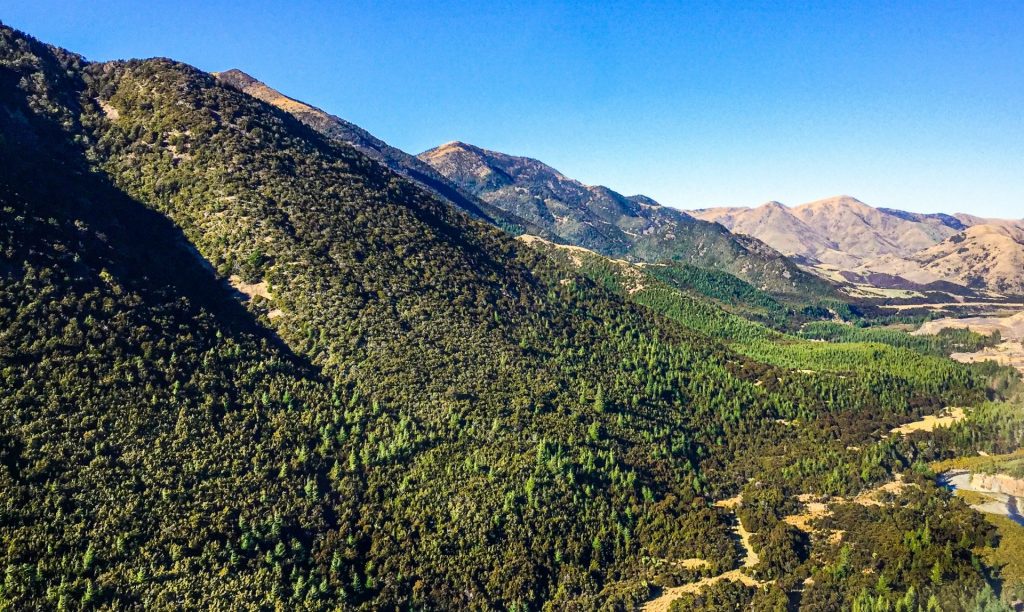 Matt Hall,
Matt Hall,Agri-Carbon Consultant,
Agri Intel
Wilding pines, often referred to as “New Zealand’s worst weed”, pose a significant threat to the ecological balance of New Zealand. Pine species such as Lodgepole pine (Pinus contorta), Douglas fir (Pseudotsuga menziesii), Scots Pine (Pinus sylvestris), Corsican Pine (Pinus nigra), to name a few. These non-native conifers not only have the potential to overtake currently unforested areas but also jeopardise the integrity of our existing native forests. With their rapid growth and ability to outcompete native flora, wilding pines have become a pressing concern for conservationists and farmers alike. The urgency to combat this pervasive problem stems not only from their negative impact on biodiversity but also from the potential loss of economic resources. Understanding the gravity of the situation, innovative approaches are emerging, exploring the use of the Emissions Trading Scheme (ETS) to not only mitigate wilding pine infestation but also generate revenue by harnessing carbon credits as these trees grow. This article delves into the innovative work we are doing by utilising the ETS as a financial tool to combat wilding pines, highlighting the dual benefits of environmental conservation and economic gains for the landowners that have significant biosecurity issues.
Having worked at Environment Canterbury and the Department of Conservation for the past 11 years, it was mind-blowing witnessing the scale at which biodiversity issues are present in New Zealand. In particular, the wilding pine issue grabbed most of my attention due to the scale, pace, and efficacy that they inflict on our country. The wilding pine issue is so widespread across New Zealand, from coastal dunes to geothermal lakes, and alpine tussock lands up to 1900m altitude on several of our high-country ranges. I don’t think the average New Zealander quite realises how close we are to seeing landscape-scale habitat and biodiversity loss, similar to what is predicted from climate change over the coming decades. An ex-colleague of mine, Graham Sullivan, once said: “due to the Government injection of funding in 2016, kiwis will never understand how close we came to seeing huge tracts of our hill and high country becoming impenetrable, uneconomic pine forests, and losing much of our beloved biodiversity”. Sadly, with the reduction in Government funding from July 2023 onwards, it is going to be a constant battle for New Zealand to even just contain these prolific spreaders.

Wilding Douglas fir regenerating aggressively within a Mānuka canopy, 2023.
We’ve witnessed wilding pine issues on countless properties in New Zealand. Without the help of Government funding, much of the responsibility to eradicate or control them has been laid on the farmer. With soaring interest rates, low market prices, and ever-increasing regulation, allocating a significant budget on controlling an issue that, in most cases wasn’t their fault to begin with is hard to fathom. We are busy helping landowners rehabilitate their land with native forestlands by leveraging the exceptional opportunity that is present by using the Emissions Trading Scheme (ETS) to capture monetary value by doing so (read here), which had us thinking – why can’t we use this scheme to strategically control plant pests that are eligible by capturing and recycling carbon credit and timber revenue back into control themselves? So that’s what we’ve done. We’ve spent time constructing a solution for landowners to eradicate wilding pines and restore native forestlands without any cost to the landowner by using the very source of the problem – the carbon sequestration and timber products that are generated from the tree’s existence. This endeavor would require collaboration from multiple government departments but could provide a solution to an already underfunded and expensive national problem.
Case study

Wilding Corsican pine in the Canterbury High country, 2023.
We have a client in the Canterbury High Country that is fortunate enough to own large areas of Mānuka and Beech Forest of which a portion of these forests are eligible to earn carbon credits (NZUs) in the ETS. Unfortunately, they also have a looming wilding pine problem, the result of a historical Government plantation of Douglas fir. Over an estimated 300 hectares, this Douglas fir has spread into nearby Mānuka and is now emerging from the canopy-forming dense thickets throughout the native. Over the next 20 to 30 years the shade tolerant Douglas fir will likely completely shade out the native forestland underneath and outcompete it in the near future if it isn’t controlled.
We have estimated that the average age of this wilding Douglas fir is approximately 15 years old. We’ll register the wilding forest into the ETS as a Standard “averaging” forest for the landowner. This category allows a first rotation forest to be registered into the ETS to earn carbon credits up until the average age of the forest typical before ‘harvest maturity’. No liability occurs for the forest in the ETS at harvest, so long as it is re-planted or regenerated to reach the carbon stocks lost in the carbon decay as a result of deforestation. Douglas fir has an average age of 26 years, therefore, this area would be eligible to earn carbon credits for the next 11 years. Over 300ha this equates to approximately 81,300 NZUs, which, at the current carbon price ($40/NZU), would equate to a revenue of $3.2million. On top of this, there would be revenue gained from the harvest of the Douglas fir, estimated to have a net return of $265,000. We are fortunate that this area is not too far from the Canterbury Plains and with the prevailing wind being Northwest, there is a low to moderate risk of further invasion to the East. Therefore, there is potentially an opportunity to utilise this resource and satisfy the relevant central and local Government organisations with a vested interest in the wilding pine problem. For forest stands closer to the main divide the risk of further invasion may be too great to justify this method.

Wilding Douglas fir re-establishing itself following harvest, 2023.
Under an agreement with the relevant Government organistations, this revenue would have to be used to control any remaining wilding pines not removed during harvesting operations, and any subsequent wilding trees that emerge following control. This of course is conditional on the fact that there are no seed sources located upwind from the area in question. At a time when pest control funding is essentially nil, employment is substantially lower. By using our method of approach, we’re able to create those jobs and increase employment using funds generated by the very problem in itself

Wilding Douglas fir re-establishing itself following control, 2023.
As with any wilding pine control, it is likely that multiple rounds of control and multiple different methods of control would need to be undertaken to remove seed remaining in the soil. Douglas fir has a coning age of approximately 12 years, therefore, control would need to be undertaken every 6 to 8 years for two to three “maintenance” cycles to ensure the removal of any trees before they are allowed to cone. The success of any control operation is of course dependent on the presence of any upwind seed sources.
Figure 1 below provides a cumulative cash flow summary of the revenue earned versus estimated control costs from now until control would likely be finished.

Figure 1: Cumulative cash flow from NZU earnings, harvest revenue, and eradication for 300ha of Douglas fir, 2023.
In summary, the wilding pine issue in New Zealand is not going to go away without some innovative thinking. At Agri Intel, we want to be a part of the solution by leading the way with initiatives that can help farmers and Government to tackle this gigantic issue…
If you have native forests that you are interested in registering into the ETS but have concerns about weed management, feel free to get in touch with the team at Agri Intel. We can guide you through the process and provide advice tailored to your specific situation.
Matt Hall – m:027 6766 587 e:matt@agriintel.co.nz


